|
|
|
Sort Order |
|
|
|
Items / Page
|
|
|
|
|
|
|
| Srl | Item |
| 1 |
ID:
186833
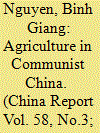

|
|
|
|
|
| Summary/Abstract |
This article examines the Communist Party of China’s (CPC) policies toward agriculture from an institutional perspective. Mao Zedong viewed the peasantry as allies of the CPC, and in order to socialise rural areas, he ordered massive collectivisation, attempting to manage the countryside and peasants with people’s communes and production brigades. Deng Xiaoping and Jiang Zemin responded to the dysfunction that followed with reforms and opening up, including the abolition of collectives and people’s communes, liberalising agriculture, and promoting incentives for labour. This led to its own complications, and efforts later by Hu Jintao and Xi Jinping have been directed towards resolving the ‘three rural issues’ – of agriculture, rural areas, and farmers – in order to achieve a ‘moderately prosperous society’ and the ‘great rejuvenation of the Chinese nation’. This article argues that while there is an emphasis on innovative policies and approaches, there is a lack of structural reforms owing to the CPC’s wish to remain in control of rural areas and peasant life.
|
|
|
|
|
|
|
|
|
|
|
|
|
|
|
|
| 2 |
ID:
141343


|
|
|
|
|
| Summary/Abstract |
The Gini Index suggests that income inequality is a highly prevalent phenomenon in Southeast Asia (The World Bank, 2012a). As Zaman and Akita (2012) points out, differentials in income is especially prominent in Bangladesh. Our article investigates which factors create differentials in income in Bangladesh. Using data from the Household Income Expenditure Survey published by the Bangladesh Bureau of Statistics, we estimated two separate models—one for daily wage and one for annual salary. We found that education, age (which was used as a proxy for labour market experience), gender and place of work significantly brought about differentials in daily wage rates. We also observed that all four of the above variables, along with different types of occupations, caused differentials in annual salary. We conclude by making several policy recommendations to address these findings.
|
|
|
|
|
|
|
|
|
|
|
|
|
|
|
|
| 3 |
ID:
163344
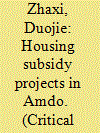

|
|
|
|
|
| Summary/Abstract |
This paper explores the ways in which housing projects in the northeastern Tibetan region of Amdo (Qinghai) produce governable citizens through rural reconstruction projects. Since the beginning of the “Construction of the New Socialist Countryside” project in 2005, the Chinese state has made great efforts to improve the living standards of rural populations, with a particular focus on the construction of “comfortable” and modern housing. This paper examines the housing subsidy projects that were launched in Amdo in 2009. Drawing on qualitative data, including participant observation and interviews, the paper examines the ways in which Tibetan villagers seek to achieve their versions of modernity through these projects. It analyzes how housing projects have encouraged villagers to become more avid market consumers by cultivating and increasing their desires for material improvement. In doing so, these projects have increased income disparities among households in the same village.
|
|
|
|
|
|
|
|
|
|
|
|
|
|
|
|
| 4 |
ID:
190413
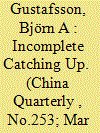

|
|
|
|
|
| Summary/Abstract |
This paper explores household income per capita for the rural Yi and Manchu ethnic minority groups and the Han majority using data from the China Household Income Project 2002, 2013 and 2018. The disparity between total per capita income for the Yi and Han populations narrowed, while the average per capita income for the Manchu population remained relatively similar to that of the Han population. Decomposing total income to its sources shows that the rapid increase in agricultural income among the Yi was a main reason why the disparity in income, compared to the two other ethnic groups, narrowed. Nevertheless, reliance on agricultural income among the Yi was reduced as wage employment and migration increased. The Manchu group and the Han group also experienced rapid increases in wages and self-employment income. The aggregated value of transfers from the public sector was similar for all three ethnic groups.
|
|
|
|
|
|
|
|
|
|
|
|
|
|
|
|
| 5 |
ID:
092871
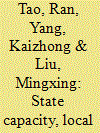

|
|
|
|
|
| Publication |
2009.
|
| Summary/Abstract |
Continued urban-rural income disparity poses a serious policy challenge in China's economic transition. As the Chinese economy booms and the state's fiscal capacity grows, there should be a corresponding increase in the center's capacity to redress urban-rural inequality. However, it seems that the stronger state extractive capacity since the mid-1990s has not translated into better urban-rural disparity outcomes. Based on a panel data set covering 270 prefectures in China between 1994 and 2003, the article evaluates the impact of local fiscal spending on urban-rural income disparity. Findings reveal a strong urban bias in China's local fiscal system under an increasingly centralized fiscal system. The centralized fiscal model has in fact reinforced this tendency and ironically weakened the capacity of the central state in achieving the policy goal of reducing the urban-rural divide.
|
|
|
|
|
|
|
|
|
|
|
|
|
|
|
|
| 6 |
ID:
121804
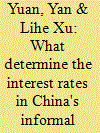

|
|
|
|
|
| Publication |
2013.
|
| Summary/Abstract |
The interest rate is one of the most important factors in farmers' decision-making of borrowing and lending in the informal financial market in China. This paper explores the determinants of the interest rate with microfinance data. Results show that the income disparity, the relationship between borrowers and lenders, the usage of borrowing, and formal credit constraints are important factors affecting interest rates. More importantly, to borrow from those in the higher income hierarchy, farmers have to bear higher interest rates. We attribute this to different social capitals across income groups and higher default risks for the poor. This paper contributes to a better understanding of the informal financial market in rural China and sheds light on the mechanism of higher informal interest rate formation.
|
|
|
|
|
|
|
|
|
|
|
|
|
|
|
|
|
|
|
|
|